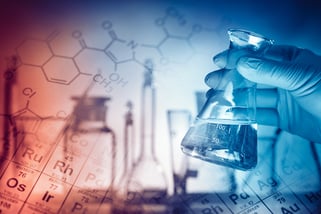ICP-OES is the go-to-technique across a number of industries, and when configured correctly, today’s instruments yield detection limits of 1 to 10 ppb for the majority of elements. Although a powerful elemental analysis technique, it is in fact a simple comparator, incapable of making absolute measurements.
.jpg?width=325&name=Crystals_cropped_iStock-661239146%20(4).jpg)
Fundamentally, qualitative identification of each element is determined by the presence or absence of emission lines and quantification is determined using the emission intensity. Unfortunately, optical spectra are very complex and variations in optical configurations mean that every ICP-OES instrument has a unique correlation between emission wavelengths and where they are positioned on the instrument’s detection system. Accurate indexing of each wavelength is critical for obtaining accurate data.
Wavelength calibration is the process used to “teach” the instrument exactly which position of its detection system corresponds to each emission wavelength. Wavelength calibration in ICP-OES is typically achieved by aspirating a multi-element solution which will produce elemental emission for each element contained in the solution. This multi-element solution should be run regularly to adjust for daily variations which inevitably can occur in the optical chamber of the ICP. The specific elements contained in the solutions are chosen to produce relatively simple spectra while also covering the relevant wavelength range of the instrument. All modern ICP-OES instruments incorporate an automated wavelength calibration routine. The instrument operator simply loads the wavelength calibration solution designed for use with their model instrument and the software does the rest.
Wavelength calibration impacts virtually every aspect of your ICP’s performance, including its sensitivity (detection limits), stability (RSDs), and susceptibility to interferences. Accuracy of the preparation of the wavelength calibration solution is directly tied to the integrity of all of the analysis performed on the calibrated instrument.  As we explored in a previous blog, Three Common Pitfalls to Avoid When Preparing Aqueous Multi-element Standards for AA, ICP, or ICP-MS, there are many opportunities to introduce inaccuracies while preparing multi-element standards. To mitigate that risk, regulations increasingly require that instrument calibrations carry international validity, particularly in industries producing legally defensible data. As a result, labs must use commercially available CRMs prepared by appropriately accredited manufacturers for all wavelength calibration. If you need help tuning your spectrometer, or selecting the appropriate wavelength calibration solution, one of our industry experts can help.
As we explored in a previous blog, Three Common Pitfalls to Avoid When Preparing Aqueous Multi-element Standards for AA, ICP, or ICP-MS, there are many opportunities to introduce inaccuracies while preparing multi-element standards. To mitigate that risk, regulations increasingly require that instrument calibrations carry international validity, particularly in industries producing legally defensible data. As a result, labs must use commercially available CRMs prepared by appropriately accredited manufacturers for all wavelength calibration. If you need help tuning your spectrometer, or selecting the appropriate wavelength calibration solution, one of our industry experts can help.
 Or if you want to know more about our Aqueous CRMs,
Or if you want to know more about our Aqueous CRMs,

